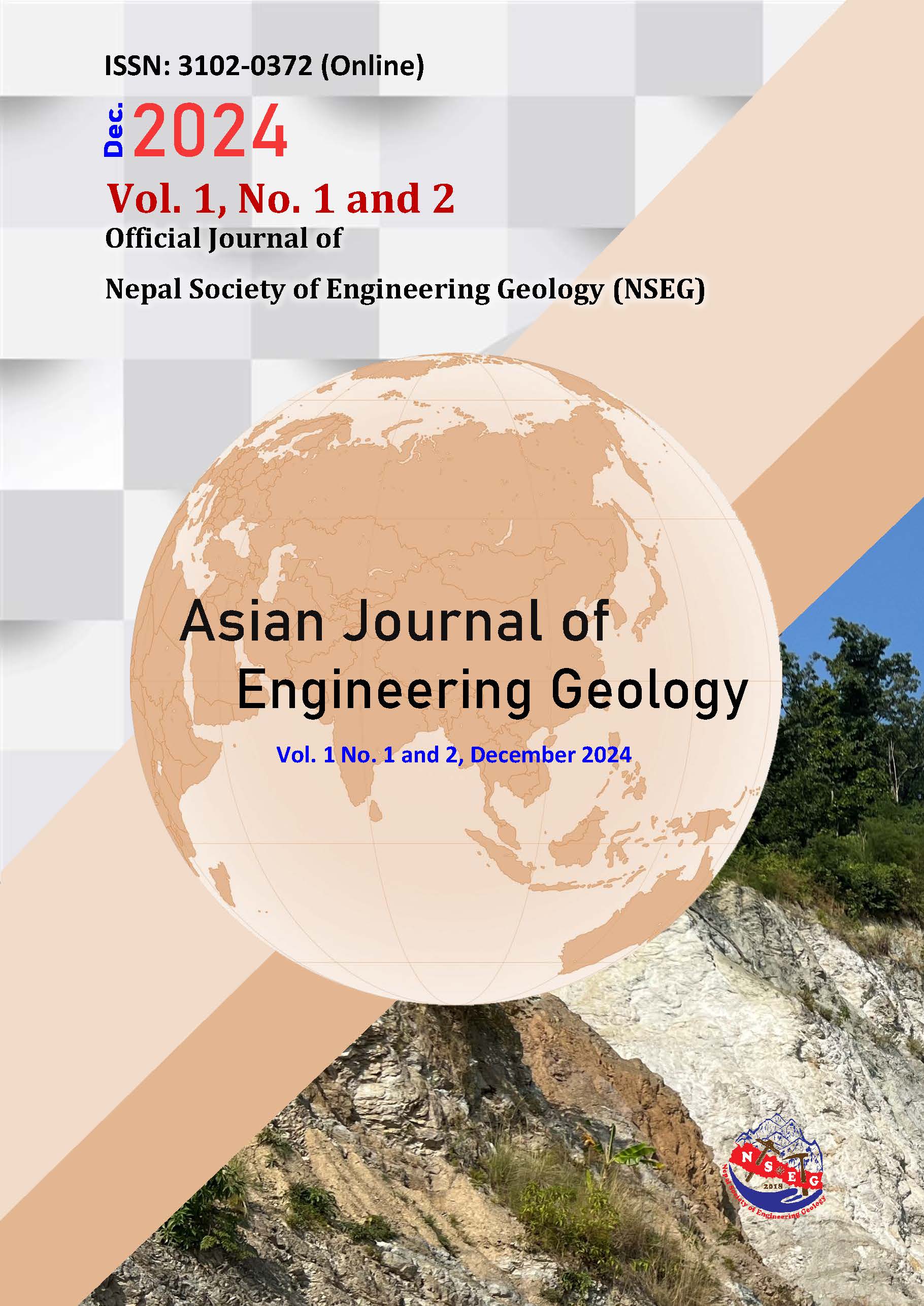Epigenetic Gorges and Their Treatments for Dam Safety: Case from Kundghat Dam, District Jamui, Bihar, India
DOI:
https://doi.org/10.64862/ajeg.2025.201.01Keywords:
Epigenetic gorges, Paleo-channel, Peninsular shield, Dam foundations, Dam safetyAbstract
A major engineering challenge was encountered during the construction of the Kundghat Dam in Bihar, India. During excavation for the dam’s foundation, a buried river channel (paleo-channel) was discovered. The paleo-channel, or epigenetic gorge, was a deeply eroded trench in the bedrock filled with highly permeable materials and proved to be a significant geological surprise. This geological feature posed two major threats: first, potential leakage due to the porous nature of the paleo-channel material, and second, settlement within such deposits. To ensure the dam’s long-term safety, a series of grouting techniques was implemented to reduce the permeability of the paleo-channel material. The remedial measures included row grouting, grout curtains, and Tube-à-Manchette (TAM) grouting, a specialized method that allows multiple, controlled injections into the same area to achieve thorough material consolidation. The use of these advanced grouting methods successfully stabilized the dam’s foundation, mitigated the risks associated with the paleo-channel, and ensured the structural integrity of the Kundghat Dam.
References
Chakraborty, A., Sharma, V., and Rath, S. (2017). Prognosis and treatment of buried channels in river valley projects: A geotechnical perspective. Journal of Engineering Geology, 42(1–2), 317–329.
Engeln von, O. D. (1942). Geomorphology: Systematic and regional (pp. 224–225). Macmillan.
Hewitt, K. (1998). Catastrophic landslides and their effects on the Upper Indus streams, Karakorum Himalaya, northern Pakistan. Geomorphology, 26(1–3), 47–80. https://doi.org/10.1016/S0169-555X(98)00051-5
Karmakar, R., Singh, S. K., and Ghoshal, T. B. (2016). [Unpublished report]. Geological Survey of India, field season 2015–2016.
Korup, O., Strom, A., and Weidinger, J. (2006). Fluvial response to large rock-slope failures: Examples from the Himalayas, the Tien Shan, and the Southern Alps in New Zealand. Geomorphology, 78(1–2), 3–21. https://doi.org/10.1016/j.geomorph.2006.01.019
Kothyari, G. C., and Juyal, N. (2013). Implications of fossil valleys and associated epigenetic gorges in parts of Central Himalaya. Current Science, 105(3), 383–387.
Ouimet, W. B., Whipple, K. X., Crosby, B. T., Johnson, J. P., and Schildgen, T. F. (2008). Epigenetic gorges in fluvial landscapes. Earth Surface Processes and Landforms, 33(13), 1993–2009. https://doi.org/10.1002/esp.1650
Pant, G. (1975). Observations on the fossil valleys and epigenetic gorges of the Bhagirathi and Alaknanda rivers. Himalayan Geology, 5, 193–206.
Pratt-Sitaula, B., Garde, M., Burbank, D., Oskin, M., Heimsath, A., and Gabet, E. (2007). Bedload-to-suspended load ratio and rapid bedrock incision from Himalayan landslide-dam lake record. Quaternary Research, 68(1), 111–120. https://doi.org/10.1016/j.yqres.2007.03.005
Ray, Y., and Srivastava, P. (2010). Widespread aggradation in the mountainous catchment of the Alaknanda–Ganga River System: Timescales and implications to hinterland–foreland relationships. Quaternary Science Reviews, 29(17–18), 2238–2260. https://doi.org/10.1016/j.quascirev.2010.05.014
Sharma, V. K. (2018). A geotechnical note on construction stage investigations at Kundaghat Dam Project, Sikandra Block, Jamui District, Bihar [Unpublished report]. Water Resources Department, Government of Bihar.
Triantafilis, J., and Buchanan, S. (2009). Identifying common near-surface and subsurface stratigraphic units using ‘Em34 water science 107’ signal data and fuzzy k-means analysis in the Darling River valley. Australian Journal of Earth Sciences, 56(4), 535–558. https://doi.org/10.1080/08120090902806330
Wray, R. A. (2009). Paleochannels of the Namoi River floodplain, New South Wales, Australia: The use of multispectral Landsat imagery to highlight a Late Quaternary change in fluvial regime. Australian Geographer, 40(1), 29–49. https://doi.org/10.1080/00049180802657007
Downloads
Published
Data Availability Statement
No datasets were generated or analyzed during this study.
Issue
Section
License
Copyright (c) 2025 Nepal Society of Engineering Geology (NSEG)

This work is licensed under a Creative Commons Attribution 4.0 International License.




